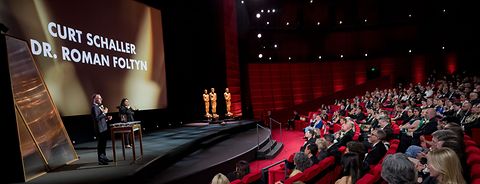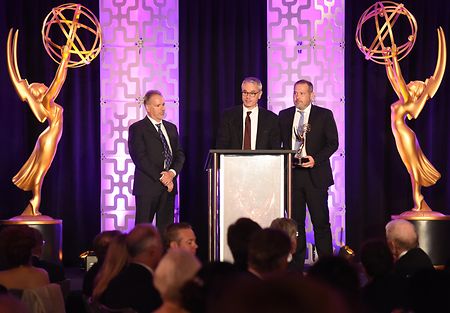Last week in Los Angeles, Curt O. Schaller, Product Manager Camera Stabilizer Systems at ARRI received a Scientific and Engineering Award from the Academy of Motion Picture Arts and Sciences for the concept, design, and development of the TRINITY 2 camera stabilizer system. His business partner Dr. Roman Foltyn, was also recognized for the software and hardware design of TRINITY’s motorized stabilized head. The Academy’s Scientific and Technical Awards honor the individuals and companies whose discoveries and innovations have contributed in significant and lasting ways to motion pictures.
The Academy’s Scientific and Technical Awards honor the men, women, and companies whose discoveries and innovations have contributed in significant and lasting ways to motion pictures. This award marks the 20th time ARRI and its engineers have received such a prestigious recognition.
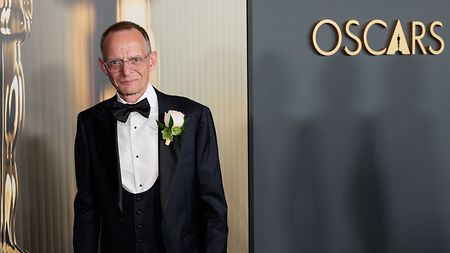
Curt O. Schaller awarded for the concept, design, and development of the TRINITY 2 camera stabilizer system.
The Academy of Motion Picture Arts and Sciences awarded 14 scientific and technical achievements, represented by 37 individual award recipients, at its annual Scientific and Technical Awards ceremony in Los Angeles on April 29, 2025. To present an introduction of the TRINITY 2 at the awards ceremony, ARRI took the opportunity to interview Curt Schaller and Dr. Roman Foltyn from its homebase in Munich.
The following interview excerpts provide interesting background into the inspiration, challenges, and achievements of the TRINITY, offering insight into Curt Schaller and Dr. Roman Foltyn’s process.
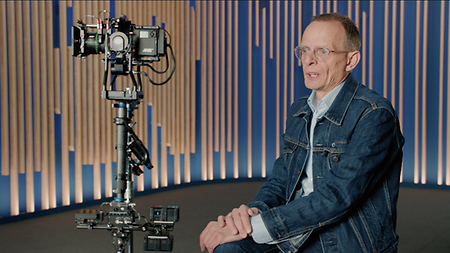
Curt O. Schaller in the ARRI Studio in Munich
What was the state of the industry before you started working on camera stabilizer tech that ultimately led to TRINITY 2?
Curt Schaller: As a DP and operator as well as a designer of camera stabilizers, I am familiar with both side of the business. In 30 years and six generations of developing the ARTEMIS body-mounted camera stabilizer, I have created a highly modular and sustainable system for evolving camera technologies and workflows on set. Despite many improvements in this particular area, there were no groundbreaking developments on the creative side.
Since Stanley Kubrick’s “The Shining” (1980), and thanks to Garret Brown, operators have embraced the innovative operating techniques from this very important film, which we still appreciate today. Despite all the improvements in hardware and the refined operating methods, however, operators still face the same operational and narrative limitations that have been present in classic body-mounted camera stabilizers for decades.
What needs in the market did you recognize that you wanted to address with TRINITY?
Curt Schaller: As an operator, I often face the same questions: How low can you go? How long to rebuild the rig from high-mode to low-mode? Can the camera move horizontally into a car or to the side of the operator? Why can’t I see the actors’ eyes when seated, or achieve a well-framed over-shoulder shot? It became clear that a classic body-mounted stabilizer cannot address these challenges.
And along comes TRINITY! What kind of tool is TRINITY and what are its key benefits?
Curt Schaller: The TRINITY System is a hybrid camera stabilizer that combines mechanical stabilization at the base with electronic stabilization at the top. Its gimbal-based design ensures excellent stabilization, especially with long lenses, providing perfect horizontal stability and consistent headroom. This allows for fluid, controlled camera movements and outstanding flexibility in filmmaking, enabling extreme angles and seamless transitions between low and high camera positions. Essentially, TRINITY functioning like a jib arm attached to an operator.
As a camera operator yourself, what makes TRINITY so special? How does it surpass the previous technologies in this area?
Curt Schaller: The main goal of the TRINITY was to overcome the known limitations of classic body-mounted stabilizers, allowing for camera movements and angles that were previously impossible. TRINITY enables seamless transitions regardless of the camera’s position. Top, bottom, front, or side, or even rolling the camera … On top, the TRINITY enables a new collaboration between the operator and the DP or director, who can control tilt and roll remotely using digital wheels, joystick, or a pan bar. For even more precise movements, tilt, roll, and lens control can be pre-programmed and triggered by either the operator or the DP or director.
It was also important to me, that we take all the operating techniques we have been working on for so many years to the next higher level. To make sure that all the experienced operators can take another big step in their personal development and career.
Roman, when you started work on stabilization systems, what did you hope to achieve?
Roman Foltyn: At the beginning of my research in mid-2013, I noticed that gimbals had a low load capacity and serious stabilization problems, and every change of lens or camera setting caused vibrations that needed to be corrected. I realized that position stabilization would be crucial as camera resolutions increased. After analyzing existing projects, I concluded that they lack sufficient stability and scalability.
As a perfectionist, my goal was to create the best possible stabilization system. In December 2013, I developed a mathematical model based on my innovative rotating axis design and by January 2014, I had built the first stabilizer: MAXIMA.
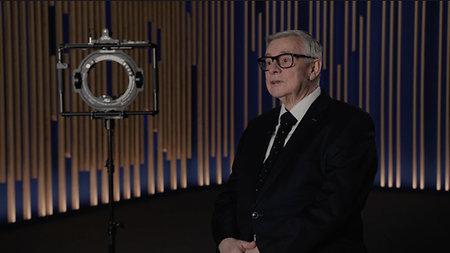
Dr. Roman Foltyn in an interview talking about his first stabilizer: MAXIMA
How did the two of you (Curt and Roman) start working together?
Curt Schaller: In 2012, I began working on the project that led to TRINITY. The emergence of handheld gimbals highlighted their potential to transform traditional body-mounted camera stabilizer systems. In 2014, I met today’s partners and friends, Roman and Rainer. Roman had designed a handheld gimbal called MAXIMA, and upon seeing its performance, I realized that combining the MAXIMA with the ARTEMIS and my vision of future operating would finally bring the TRINITY concept to life.
Roman Foltyn: In September 2014, Curt approached me with a vision for a new generation of body-mounted camera support systems that had additional stabilization axes similar to MAXIMA. Recognizing its potential, I joined the project, and Curt integrated the MAXIMA system into his improved ARTEMIS stabilizer.
Curt Schaller: The MAXIMA design provided a key advantage over all other gimbals by placing the camera in a weight-neutral position inside a ring. All weight-relevant components, including the camera, lens and drive motors, are mounted on this ring, allowing the center of gravity to align perfectly with the vertical axis of the ARTEMIS system. This design enables effortless maneuvering of the camera into all the new angles and positions while maintaining the overall system balance.
Roman Foltyn: In 2020, we jointly obtained a patent for TRINITY. Our latest electronics use advanced sensors and multi-core processors, providing capabilities for future tasks. In addition, we have improved the algorithms for processing sensor signals, significantly improving stabilization and dynamics. The system offers the highest level of stabilization and a 360-degree rotation axis for creative shots.
What were the main developments that ultimately culminated in the creation of the TRINITY 2?
Curt Schaller: TRINITY was not created overnight. Many components, like the gimbal, center post and high-capacity power supply, were developed from 30 years of experience, including special stabilizers made for 3D camera applications. These parts were redesigned and optimized for TRINITY to enhance Roman’s gimbal performance.
Another challenge was developing a user-friendly software, as classic operators had not previously programmed their stabilizers.
Roman and I put our heads together on this: I designed the user-friendly frontend interface while Roman and his team focused on the algorithms and other outstanding software functionality.
Roman Foltyn: Together with my developers, I concentrated on the algorithms and other unique features of the TRINITY software. Working with experienced operators, we developed a modern user interface with a unified menu structure, which makes configuration quick and intuitive.
How does TRINITY 2 assist artists and filmmakers in making their art?
Curt Schaller: Imagine a scene in an apartment where adults and children are talking to each other and moving around. With a classic body-mounted stabilizer, the operator must choose a high camera position, making it difficult to capture the children properly. In contrast, TRINITY allows for eye-level shots with both adults and children, even placing the camera low behind the children to create an upward perspective. TRINITY enables all these individual frames to come together in one long take. And sometimes very long takes!
What are some of your favorite movies or scenes where TRINITY was behind the scenes?
Curt Schaller: TRINITY has been featured in countless breathtaking films, series, commercials, and music events, transforming not just their look but also their design and storytelling. A prime example is “1917,” where Sir Roger Deakins and Sam Mendes showcase TRINITY’s creative flexibility, allowing for endoscopic-like camera movements. This capability was crucial for scenes like the complex plane crash sequence, one of the longest continuous shots in “1917.” Studying the behind-the-scenes footage of “1917” reveals how Roger Deakins effectively utilized different types of camera stabilization to keep pushing the story forward.
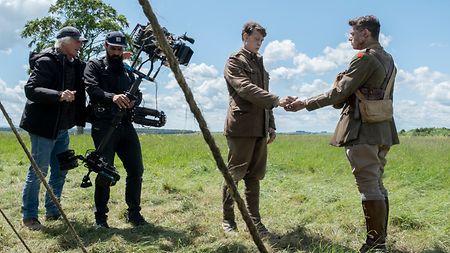
Sir Roger Deakins CBE, ASC, BSC (l.) and TRINITY operator Charlie Rizek on the set of “1917” with actors George MacKay and Richard Madden
How does it feel seeing your technology used on the big screen?
Curt Schaller: Thanks to good social media, I get to watch TRINITY operators worldwide every day as they work with directors and DPs to bring new and outstanding creative ideas and camera movements to life. When I see the results later on the big screen, or at home, I often have to fight back tears of joy.
Roman Foltyn: Seeing my technology on the big screen gives me great satisfaction, knowing that I have contributed to a wonderful experience for the audience.
What is the best compliment your tech has received from a filmmaker or DP?
Curt Schaller: The highest praise for the TRINITY team is the fact that once a director or DP has successfully collaborated with an experienced TRINITY operator, they are unlikely to want to work without TRINITY in the future.
What do you see as the future for this technology?
Curt Schaller: The future is arriving faster than many realize, which is why we are working diligently to stay ahead. I prefer to keep our future plans under wraps for now but stay tuned for exciting developments to come!
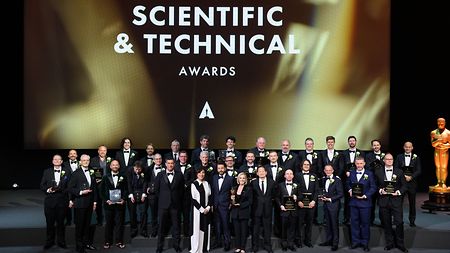
The 2024 Scientific and Technical Award winners at the Academy Museum of Motion Pictures on Tuesday, April 29, 2025.
Front Center: Darin Grant, Academy President Janet Yang, Diego Luna, Marlee Matlin and Raymond Yeung.
Steve Wagner, Jayson Dumenigo, Jerry Holway, Dustin Brooks, Colin Decker, Fabrice Rousselle, Gerhard Röthlin, David Adler, Mark Meyer, Dave Freeth, Jerry Holway, Thijs Vogels, Dan Raviv, Nir Averbuch, Yair Chuchem, Mark Noel, Javor Kalojanov, Essex Edwards, James Jacobs, Jernej Barbic, Andrew van Straten, Crawford Doran, David Bloomfield, Kimball Thurston, Shane Colton, Timo Aila, Curt Schaller, Neeme Vaino and Tabb Firchau.
To learn more about TRINITY behind the scenes of “1917,” please visit: here
Opening Image:
Curt O. Schaller on stage at the Scientific & Technical Awards ceremony in Los Angeles. ©A.M.P.A.S. Al Seib / The Academy
